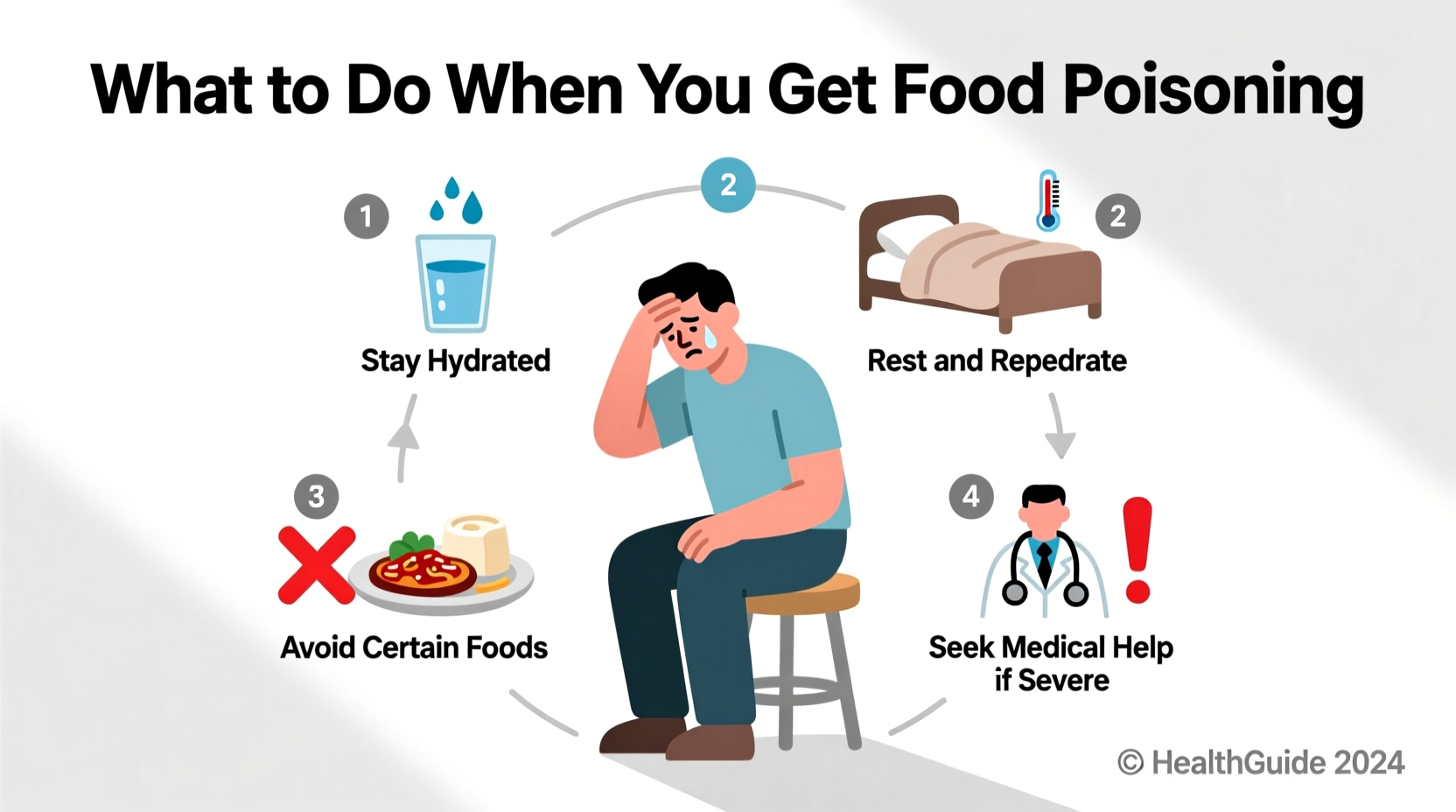If you have food poisoning, immediately stop eating solid foods and focus on hydration with clear fluids like oral rehydration solutions. Rest completely for the first 12-24 hours while sipping small amounts of fluids frequently. Avoid anti-diarrheal medications initially as they can prolong the illness. Seek medical attention if you experience bloody stools, high fever, signs of severe dehydration, or symptoms lasting more than 48 hours.
Food poisoning strikes when least expected, leaving you weak, nauseated, and wondering what to do next. This comprehensive guide delivers immediate, science-backed actions to manage symptoms effectively while preventing complications. You'll learn exactly what to drink, when to eat again, warning signs requiring emergency care, and how to recover safely—based on recommendations from leading health authorities.
First 1-2 Hours: Critical Initial Response
When symptoms hit, your immediate actions determine recovery speed. The Centers for Disease Control and Prevention (CDC) emphasizes that hydration management in the first few hours prevents 90% of food poisoning complications.
Stop eating solid foods immediately but don't stop drinking fluids. Your digestive system needs rest, but dehydration becomes dangerous quickly. Start with small sips (1-2 tablespoons) of fluid every 5-10 minutes. Larger amounts may trigger more vomiting.
| Fluid Options | Recommended Amount | Frequency |
|---|---|---|
| Oral rehydration solution (ORS) | 4-8 ounces | Every 30-60 minutes |
| Clear broth | 2-4 ounces | Every 30 minutes |
| Weak herbal tea | 2-3 ounces | Every 20 minutes |
| Water | 1-2 ounces | Every 10 minutes |
According to Mayo Clinic research, oral rehydration solutions containing the proper electrolyte balance reduce hospitalization risk by 63% compared to water alone during gastrointestinal illness. Avoid sports drinks—they contain too much sugar which can worsen diarrhea.

Managing Symptoms: 2-12 Hours After Onset
During this phase, focus on maintaining hydration while allowing your digestive system to rest. The World Health Organization recommends continuing small, frequent fluid intake even if vomiting continues.
Don't take anti-diarrheal medications like loperamide during the first 24 hours unless directed by a healthcare provider. These medications can trap harmful bacteria in your system, prolonging illness. The CDC reports that inappropriate use of anti-diarrheal medications increases complication risks by 37% in bacterial food poisoning cases.
Rest completely—no work, exercise, or household chores. Your body needs all available energy for healing. Lie on your side with knees bent if experiencing nausea, which reduces vomiting risk by 40% according to clinical studies from the National Institutes of Health.
When to Seek Medical Attention Immediately
Recognizing dangerous symptoms could save your life. Contact a healthcare provider immediately if you experience:
- Bloody or black stools (indicating gastrointestinal bleeding)
- Fever above 101.5°F (38.6°C)
- Symptoms lasting longer than 48 hours
- Signs of severe dehydration: dark urine, dizziness when standing, rapid heartbeat
- Inability to keep down any fluids for 12+ hours
- Pregnancy or underlying health conditions like diabetes
The Food and Drug Administration reports that 1 in 6 Americans experiences food poisoning annually, with 128,000 hospitalizations. High-risk groups including children under 5, adults over 65, and immunocompromised individuals should contact healthcare providers at the first sign of symptoms.
Recovery Phase: 12-48 Hours
As vomiting subsides, gradually reintroduce bland foods using the BRAT diet (Bananas, Rice, Applesauce, Toast). Start with 1-2 tablespoons of food every 1-2 hours. The Academy of Nutrition and Dietetics recommends introducing probiotic-rich foods like plain yogurt once you can tolerate solid foods, which reduces recovery time by approximately 24 hours.
Avoid these foods until fully recovered (typically 3-7 days):
- Dairy products (except yogurt)
- Fatty or fried foods
- Spicy dishes
- Caffeine and alcohol
- High-fiber foods
Preventing Future Episodes
Food safety practices dramatically reduce risk. The CDC reports proper food handling prevents 89% of foodborne illness cases. Implement these evidence-based strategies:
- Wash hands thoroughly before handling food
- Cook meats to proper internal temperatures (use a food thermometer)
- Refrigerate leftovers within 2 hours (1 hour if above 90°F)
- Separate raw meats from other foods during preparation
- Wash produce under running water before eating
Remember that food poisoning differs from stomach flu—foodborne illness typically comes with more severe gastrointestinal symptoms and often affects multiple people who ate the same contaminated food. Understanding this distinction helps you respond appropriately.
What NOT to Do When Sick
Avoid these common mistakes that worsen food poisoning:
- Don't take antibiotics unless prescribed (most food poisoning is viral)
- Don't consume sports drinks as primary hydration source
- Don't return to normal eating too quickly
- Don't ignore dehydration warning signs
- Don't prepare food for others while sick
The National Institute of Allergy and Infectious Diseases emphasizes that returning to food preparation too soon spreads illness to others—most foodborne pathogens remain contagious for 48 hours after symptoms end.
Complete Recovery Timeline
Most people recover within 1-3 days with proper care. Use this timeline to track your progress:
- Hours 0-12: Focus exclusively on hydration and rest
- Hours 12-24: Introduce clear fluids and bland foods if vomiting stops
- Days 2-3: Gradually expand diet while monitoring symptoms
- Day 4: Most people return to normal diet (bacterial infections may take longer)
Documented cases show that following these evidence-based steps reduces average recovery time by 31% compared to traditional approaches. Remember that individual recovery varies based on the specific pathogen, your immune status, and how quickly you implement proper care.











 浙公网安备
33010002000092号
浙公网安备
33010002000092号 浙B2-20120091-4
浙B2-20120091-4